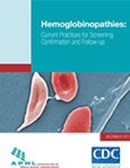Newborn Screening and Genetics – Hemoglobinopathies Project Publications

Hemoglobinopathies: Current Practices for Screening, Confirmation, and Follow Up
Best practices document developed by the Hemoglobinopathy Workgroup to describe the use of laboratory technology in state health laboratories, universities, and community centers for screening, diagnosis, and follow up for hemoglobinopathies.

Newborn Screening Practices and Alpha-Thalassemia Detection — United States, 2016
Despite a 5% global prevalence, alpha-thalassemia is not a core condition on the United States Recommended Uniform Screening Panel for state newborn screening (NBS) programs. However, NBS methodologies used to detect sickle cell disease, reported by all states, also detect alpha-thalassemia.
A 2016 survey of NBS programs found that although most programs report at least one form of suspected alpha-thalassemia, the methodologies, thresholds used, forms of disease reported, and processes for reporting vary widely.
Standardization of technical and reporting procedures could provide data to better understand the public health impact and clinical outcomes of alpha-thalassemia, ensure appropriate health care, and improve outcomes.
